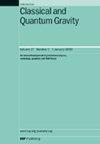The Smarr formula within the Geroch-Held-Penrose formalism
IF 3.6
3区 物理与天体物理
Q2 ASTRONOMY & ASTROPHYSICS
引用次数: 0
Abstract
The connection between classical thermodynamics and black hole horizons is a fundamental topic in gravitational physics, offering a potential pathway to understanding quantum aspects of gravity. However, while black hole mechanics exhibits well-known thermodynamic parallels, a rigorous geometric interpretation of thermodynamic variables directly from the field equations warrants further research. In this manuscript, we present a thermodynamic formulation of the field equations through the decomposition of the Riemann tensor, employing the Geroch-Held-Penrose (GHP) formalism, to clarify a strong correspondence between black hole thermodynamic variables and geometrical quantities derived from horizon geometry. Our analysis reveals an intrinsic connection between the Penrose and Rindler K-curvature and the Smarr relation, motivating a revised definition of both trapping gravity and black hole internal energy. Additionally, we derive through this GHP formalism the Smarr formula for the Reissner–Nördstrom black hole cointained in an AdS spacetime and we explore the implications of this relationship for black holes with exotic topologies and in the context of extended theories, exemplified by f(R) gravity. We also briefly analyze this relation in more general configurations, such as Taub-NUT spacetimes. These findings suggest a deeper geometrical basis for black hole thermodynamics, potentially advancing our understanding of gravitational energy, horizon entropy, and their significance within quantum gravity frameworks.Geroch-Held-Penrose形式主义中的Smarr公式
经典热力学和黑洞视界之间的联系是引力物理学的一个基本主题,为理解引力的量子方面提供了一条潜在的途径。然而,虽然黑洞力学表现出众所周知的热力学相似性,但直接从场方程中对热力学变量进行严格的几何解释值得进一步研究。在本文中,我们通过黎曼张量的分解,采用Geroch-Held-Penrose (GHP)形式,提出了场方程的热力学公式,以阐明黑洞热力学变量与视界几何导出的几何量之间的强烈对应关系。我们的分析揭示了Penrose和Rindler k曲率与Smarr关系之间的内在联系,从而推动了对捕获引力和黑洞内能的修订定义。此外,我们通过这种GHP形式推导出AdS时空中包含的Reissner-Nördstrom黑洞的Smarr公式,并在扩展理论(以f(R)引力为例)的背景下,探索具有奇异拓扑的黑洞的这种关系的含义。我们也简要地分析了这种关系在更一般的构型中,如Taub-NUT时空。这些发现为黑洞热力学提供了更深层次的几何基础,有可能推进我们对引力能、视界熵及其在量子引力框架中的重要性的理解。
本文章由计算机程序翻译,如有差异,请以英文原文为准。
求助全文
约1分钟内获得全文
求助全文
来源期刊

Classical and Quantum Gravity
物理-天文与天体物理
CiteScore
7.00
自引率
8.60%
发文量
301
审稿时长
2-4 weeks
期刊介绍:
Classical and Quantum Gravity is an established journal for physicists, mathematicians and cosmologists in the fields of gravitation and the theory of spacetime. The journal is now the acknowledged world leader in classical relativity and all areas of quantum gravity.
 求助内容:
求助内容: 应助结果提醒方式:
应助结果提醒方式:


